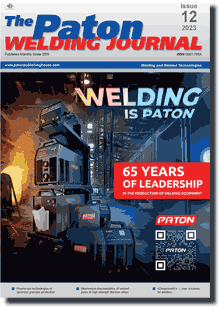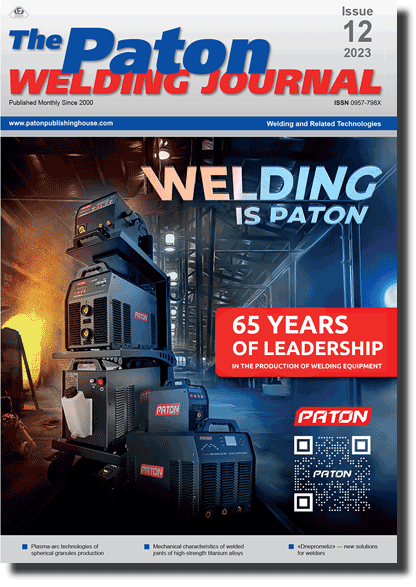| 2023 №12 (01) |
DOI of Article 10.37434/tpwj2023.12.02 |
2023 №12 (03) |

The Paton Welding Journal, 2023, #12, 19-23 pages
Influence of blowing and loading of working space on mechanical properties of samples manufactured using SLM technology
S.V. Adzhamskyi2, G.A. Kononenko3, R.V. Podolskyi3, S.I. Badyuk1
1LLC «Additive Laser Technology of Ukraine». 49000, Serhiy Podolynskyi, 31 v str., Dnipro, E-mail: info@alt-print.com2Institute of Transport Systems and Technologies of the NAS of Ukraine, 49000, Pysarzhevsky 5 str., Dnipro E-mail: itst@westa-inter.com
3Z.I. Nekrasov Iron and Steel Institute. National Academy of Sciences of Ukraine. 1 Academician Starodubov Sq., 49000, Dnipro, Ukraine. E-mail: office.isi@nas.gov.ua
Abstract
At present for selective laser melting (SLM, Selective Laser Melting (SLM)), studying the influence of the characteristics of blowing and loading of the working space on mechanical properties of titanium Ti6Al4V alloy is an urgent task. In the work, tensile samples were studied, for which as a result of different loading of the building space, there was a pause of different duration between the application of powder and return of the laser beam. Based on the analysis of the values of mechanical properties, it was found that characteristics of strength of test samples in the area of the inlet nozzle of inert gas blowing have a value lower by 3...5% compared to the central area of the platform with a range of values of ± 2%, in the area of the outlet nozzle, the value is lower by 3...5% compared to the central area, a range of values is ± 10%. It was found that an increase in the pause from 50 to 65 s leads to a decrease in strength and ductility characteristics by 23 and 10%, up to 80 s by 33 and 0.7%, respectively. Ref. 16, Tabl. 1, Fig. 6.
Keywords: selective laser melting, blowing, loading of the working space, Ti6Al4V alloy, mechanical properties
Received: 23.10.2023
Accepted: 26.12.2023
References
1. Williams, R.J., Piglione, A., Rønneberg, T. et al. (2019) In situ thermography for laser powder bed fusion: Effects of layer temperature on porosity, microstructure and mechanical properties. Additive Manufacturing, 30, 100880. https://doi.org/10.1016/j.addma.2019.1008802. Grasso, M., Colosimo, B.M. (2017) Process defects and in situ monitoring methods in metal powder bed fusion: a review. Measurement Science and Technology, 28, 044005. https://doi.org/10.1088/1361-6501/aa5c4f
3. Aage, N., Andreassen, E., Lazarov, B.S., Sigmund, O. (2017) Giga-voxel computational morphogenesis for structural design. Nature, 550, 84-86. https://doi.org/10.1038/nature23911
4. Wang, P., Song, J., Nai, M.L.S., Wei, J. (2020) Experimental analysis of additively manufactured component and design guidelines for lightweight structures: A case study using electron beam melting. Addit. Manuf., 33, 101088. https://doi.org/10.1016/j.addma.2020.101088
5. Adjamskiy, S., Kononenko, G., Podolskyi, R., Badyuk, S. (2022) Implementation of selective laser melting technology in Ukraine. Kyiv, Naukova Dumka. https://doi.org/10.15407/978-966-00-1856-3
6. Fu, D., Li, X., Zhang, M. et al. (2020) Influence of effective laser energy on the structure and mechanical properties of laser melting deposited Ti6Al4V alloy. Materials (Basel), 13(4), 962. https://doi.org/10.3390/ma13040962
7. Gong, H., Gu, H., Zeng, K. et al. (2014) Melt pool characterization for selective laser melting of Ti-6Al-4V prealloyed powder. Solid Freeform Fabrication Symposium, Austin Texas, pp. 256-267. DOI: http://dx.doi.org/10.26153/tsw/15682
8. Amano, H., Ishimoto, T., Suganuma, R. et al. (2021) Effect of a helium gas atmosphere on the mechanical properties of Ti- 6Al-4V alloy built with laser powder bed fusion: A comparative study with argon gas. Additive Manufacturing, 48(B), 102444. https://doi.org/10.1016/j.addma.2021.102444
9. Xiao, L., Song, W., Hu, M., Li, P. (2019) Compressive properties and micro-structural characteristics of Ti-6Al- 4V fabricated by electron beam melting and selective laser melting. Mater. Sci. Eng.:A, 764, 138204. https://doi.org/10.1016/j.msea.2019.138204
10. Herzog, D., Seyda, V., Wycisk, E., Emmelmann, C. (2016) Additive manufacturing of metals. Acta Mater., 117, 371- 392. https://doi.org/10.1016/j.actamat.2016.07.019
11. Nguyen, D.S., Park, H.S., Lee, C.M. (2018) Effect of cleaning gas stream on products in selective laser melting. Materials and Manufacturing Processes, 34(4), 455-461. https://doi.org/10.1080/10426914.2018.1512132
12. Liu, Z., Yang, Y., Wang, D. et al. (2022) Flow field analysis for multilaser powder bed fusion and the influence of gas flow distribution on parts quality. Rapid Prototyping J., 28(9), 1706-1716. https://doi.org/10.1108/RPJ-12-2021-0351
13. Ferrar, L. Mullen, E. Jones, R. Stamp, C.J. Sutcliffe (2012) Gas flow effects on selective laser melting (SLM) manufacturing performance. J. of Materials Processing Technology, 212(2), 355-364. https://doi.org/10.1016/j.jmatprotec.2011.09.020
14. Zhao, C., Fezzaa, K., Cunningham, R.-W. et al. (2017) Realtime monitoring of laser powder bed fusion process using high-speed X-ray imaging and diffraction. Sci. Rep., 7, 3602. https://doi.org/10.1038/s41598-017-03761-2
15. Hiroshi, N., Yousuke, K., Koji, N., Seiji, K. (2015) Elucidation of melt flows and spatter formation mechanisms during high power laser welding or pure titanium. J. Laser Appl., 27, 032012. https://doi.org/10.2351/1.4922383
16. Adjamskyi, S.V., Kononenko, G.A., Podolskyi, R.V. (2022) Influence of heat treatment of specimens from Ti6Al4V manufactured by the technology of selective laser melting on structure and mechanical properties. The Paton Welding J., 9, 21-26. https://doi.org/10.37434/tpwj2022.09.04
Suggested Citation
S.V. Adzhamskyi, G.A. Kononenko, R.V. Podolskyi, S.I. Badyuk (2023) Influence of blowing and loading of working space on mechanical properties of samples manufactured using SLM technology. The Paton Welding J., 12, 19-23.The cost of subscription/purchase order journals or individual articles
| Journal/Currency | Annual Set | 1 issue printed |
1 issue |
one article |
| TPWJ/USD | 384 $ | 32 $ | 26 $ | 13 $ |
| TPWJ/EUR | 348 € | 29 € | 24 € | 12 € |
| TPWJ/UAH | 7200 UAH | 600 UAH | 600 UAH | 280 UAH |
| AS/UAH | 1800 UAH | 300 UAH | 300 UAH | 150 UAH |
| AS/USD | 192 $ | 32 $ | 26 $ | 13 $ |
| AS/EUR | 180 € | 30 € | 25 € | 12 € |
| SEM/UAH | 1200 UAH | 300 UAH | 300 UAH | 150 UAH |
| SEM/USD | 128 $ | 32 $ | 26 $ | 13 $ |
| SEM/EUR | 120 € | 30 € | 25 € | 12 € |
| TDNK/UAH | 1200 UAH | 300 UAH | 300 UAH | 150 UAH |
| TDNK/USD | 128 $ | 32 $ | 26 $ | 13 $ |
| TDNK/EUR | 120 € | 30 € | 25 € | 15 € |
AS = «Automatic Welding» - 6 issues per year;
TPWJ = «PATON WELDING JOURNAL» - 12 issues per year;
SEM = «Electrometallurgy Today» - 4 issues per year;
TDNK = «Technical Diagnostics and Non-Destructive Testing» - 4 issues per year.


